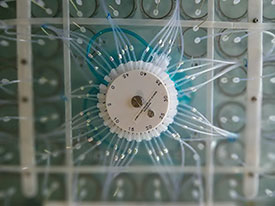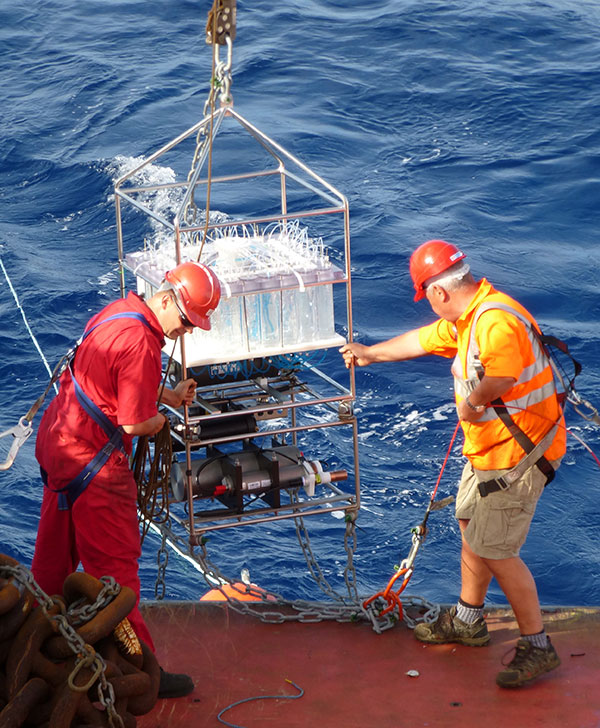
You are here: RAPID » ABC Home » ABC research » New ABC observatons

Figure 1. RAS and sensors deployed. Larger figure

Figure 2. RAS seen from the top. MORE

Figure 3. Ph, T, S and oxygen sensors. MORE

Figure 4. pCO2 sensor, pump and battery. MORE

Figure 5. Sensors on the mooring wire. MORE
New ABC observations
New sensors and samplers extending the capabilities of the RAPID array
As part of the most recent RAPID cruise (Oct-Dec 2015), biogeochemical sensors and samplers have now been deployed at four locations across the subtropical North Atlantic: two are at the western boundary (one at 1500m depth, one at 50m depth), one is on the western flank of the Mid-Atlantic Ridge, and the last is towards the eastern boundary. At all four locations, oxygen sensors have also been installed at multiple depths throughout the full water column. These additions to the RAPID array will increase our understanding of the biogeochemistry of the North Atlantic.
Biogeochemistry is the science that studies the chemical, physical, geological, and biological processes and reactions that govern the composition of the natural environment. Biogeochemical cycles include the carbon cycle, the water cycle and various nutrient cycles (nitrogen, phosphorus, iron ..), which describe how the different elements flow through the Earth system.

Locations of the RAPID moorings and where biogeochemical observations are made.
The new sensors added to the moorings are described below.
Remote Access Sampling of the Water
The largest component of the new instrumentation is the McLane Remote Access Sampler (RAS) that has space to collect 48 unique water samples (figure 1).
These work by using empty plastic sampling bags that are enclosed within sealed acrylic cylinders filled with water. Over the next 15 months or so, every 11 days the integral valve will select a new port / bag to fill. Water is pumped out of the bottom of the acrylic cylinder, creating a pressure gradient that draws local seawater through the sample inlet and into the bag.
A preservative in the sample lines ensures that the chemistry of the collected water will not change while the sample is waiting to be collected in spring 2017. When the sample bag is full, the valve turns back to its home position, and the bag with its water sample becomes, like a desert island, isolated until it can be analysed in the laboratory.
Oxygen, CO2 and pH sensors
The biogeochemical sensors are located in an additional frame attached to the bottom of the RAS, along with the temperature, salinity and pressure (depth) sensors (figure 2).
Near the top is a Seabird Satlantic Deep SeapHOx, a combined temperature, salinity, pressure, oxygen and pH sensor. These are the first deep-rated SeapHOx sensors to be deployed, and use the ISFET pH technology that has been successfully used in SOCCOM profiling floats in the Southern Ocean.
The SOCCOM (Southern Ocean Carbon and Climate Observations and Modeling) project is a US research programme to determine the Southern Ocean's influence on climate. SOCCOM profiling floats have successfully collected biogeochemical measurements down to well below 1000 m depth.
At the bottom of the frame is located the Contros HydroC pCO2 sensor (figure 3). This uses a small pump to force local seawater past a membrane that is permeable to CO2. Over time, the CO2 in the seawater equilibrates with the airspace behind the membrane before being pumped into an enclosed detector and analysed by infrared spectroscopy.
In order to stop water vapour condensing within the detector, the internal mechanisms need to be kept at a much higher temperature than the local environment. In the warm and balmy subtropics and for such a long deployment (up to 18 months) this becomes quite a power-intensive process, hence the weighty power pack.
Oxygen sensors on the mooring wire
The final constituents of the new ABC Fluxes observational array are not attached to the RAS frame. Instead they are installed on the mooring wire, spaced at regular intervals down to the ocean bottom. In total, 24 combined temperature, salinity, pressure (depth) and oxygen sensors (Seabird SBE63 ODO mounted on microCAT CTD) have been installed along the four mooring wires where the RAS and other sensors are located, with a fifth at the western boundary.

RAS deployment Video (5 MB)
Together these sensors will create a high frequency time-series of the full-depth transatlantic distribution of oxygen.
The autonomous samplers and biogeochemical sensors will provide a substantial chemical upgrade to the successful RAPID mooring array. Once the sensors have been retrieved been and the water samples analysed, the data should help us gain a better understanding of what controls the variability in chemical fluxes on different time scales.
The data will give us information about biogeochemical process both within the ocean and at the sea surface interface, hopefully improving our ability to estimate the transports of total, natural and anthropogenic carbon, and inorganic nutrients in the subtropical North Atlantic.










Figure 1. Remote access samplers (RAS) and biogeochemical sensors being deployed at mooring EB1 (eastern boundary).

Figure 2. Flower Power: birds-eye view of the multiple tubes leading from the central multi-position valve to individual sample bags and cylinders on the remote access sampler.

Figure 3. pH sensor (black cylinder, foreground), temperature, salinity, pressure and oxygen sensor (silver cylinder with circular-holed guard, centre-ground), temperature/salinity/pressure sensor (below)

Figure 4. Final part of the frame-enclosed ABC sensor suite: pump (front), pCO2 sensor (centre), battery pack (back).

Figure 5. MicroCATs are not deployed in a frame, but installed on the mooring wire, spaced at regular intervals down to the ocean bottom. Basic MicroCATs measure temperature, salinity and pressure. The ones seen here also have a sensor that measures dissolved oxygen in the water. In total, 24 combined temperature, salinity, pressure and oxygen sensors (Seabird SBE63 ODO mounted on microCAT CTD) have been installed along the four mooring wires where the RAS and other sensors are located.
Time lapse video showing the deployment of ABCs remote access sampler on RAPID mooring EB1 at the the eastern boundary of the North Atlantic gyre at 26°N.